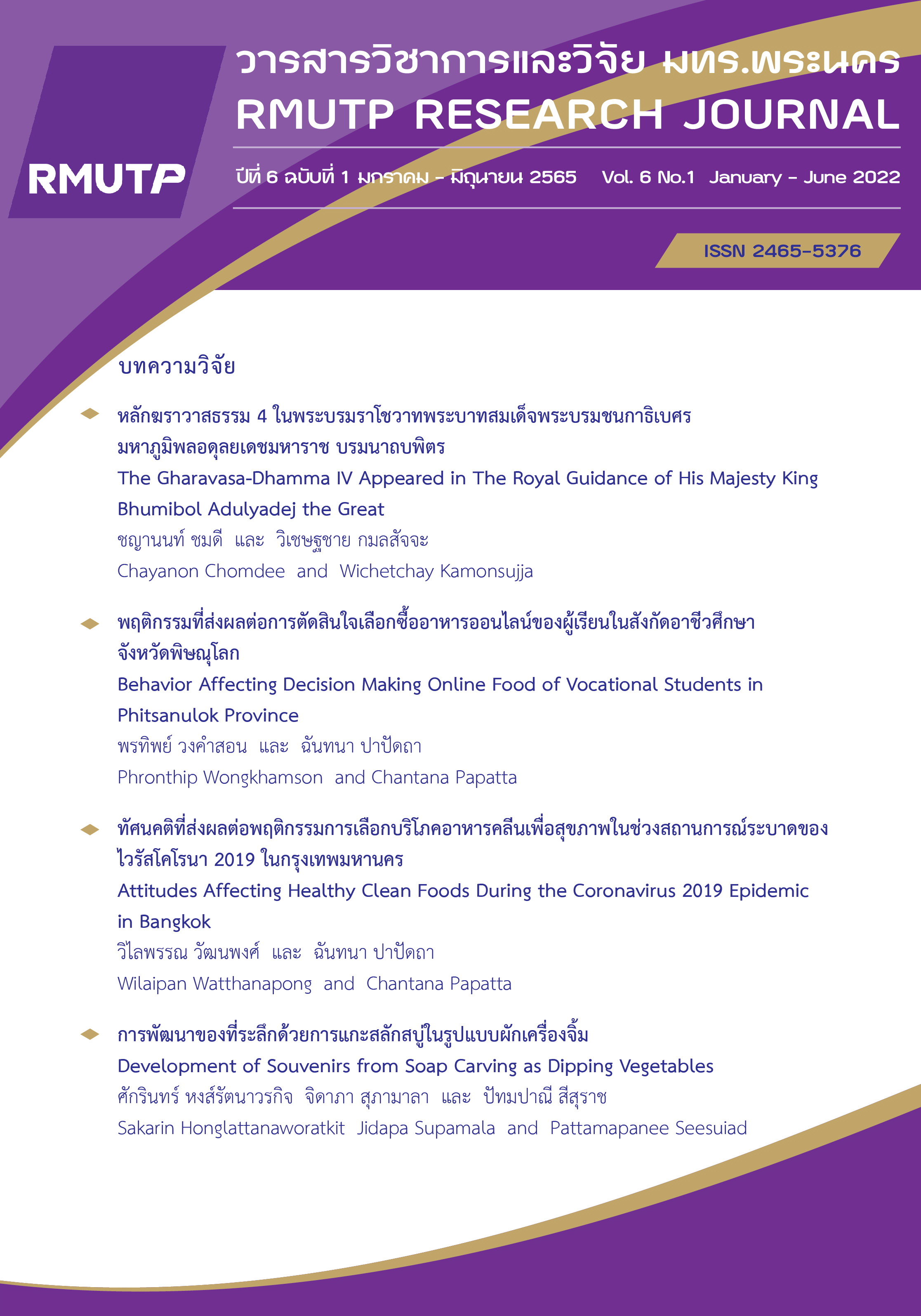Development of Souvenirs from Soap Carving as Dipping Vegetables
Main Article Content
Abstract
The objectives of this research are to study the Development of Souvenirs from Soap Carving as Dipping Vegetables. the researcher aimed to investigate the target group’s satisfaction on Souvenirs from Soap Carving as Dipping Vegetables. The researcher examined five methods of soap making from plentiful soaps, and then the researcher designed one drafting of soap carving method and determined the size of container for containing carved-soap, types of vegetable, patterns of leaf, patterns of flower, dipping sauce container, and dyeing colors. Then these aforementioned details of soap carving were considered by five experts, and they chose the method of soap making and overall patterns for developing of a carved-soap product as a souvenir adapting the technique of dipped-vegetable carving. After that the products were the instrument for observing target’s group satisfaction amount 100 participants. The data were analyzed as means, percentage, and standard deviation. The results revealed that. Most experts have chosen the soap type no.5, given that soap texture is fine, smooth, sticky. The Almost of experts chose the 8 inches diameter of sphere containers. The vegetables that were chosen for carving were long cucumbers, cucumbers, carrots, eggplants, Thai eggplants, white eggplants, white turmeric, and long beans. For the leaves-carving, the patterns of leaves were grooving and stencil. The patterns of flowers-carving were single layer flower pattern, alternating flower pattern, and long-shaped flower pattern. Along with the pattern of container-carving for chilling paste was the container with lid pattern, and the colors for soap painting was batik dyeing color. The satisfaction level of the target group toward the product, The highest level of an average of 4.82 for the elegance of the product. The creativity of the materials is at the highest level of an average of 4.74. The value and utility of the product for a souvenir are at the highest level with an average of 4.90.
Article Details
References
กรมส่งเสริมวัฒนธรรม กระทรวงวัฒนธรรม. (2559). วัฒนธรรม วิถีชีวิตและภูมิปัญญา. กรุงเทพฯ : บริษัทรุ่งศิลป์การพิมพ์ (1977) จำกัด.
คนึงนิจ กัณหะกาญจนะ. (2554). ศิลปะการแกะสลักผักและผลไม้. กรุงเทพฯ : โอเดียนสโตร์.
จอมขวัญ สุวรรณรักษ์ และนิธิยา รัตนาปนนท์. (2558). เทคโนโลยีการแกะสลักผักและผลไม้. กรุงเทพฯ : โอเดียนสโตร์.
จอมขวัญ สุวรรณรักษ์ และอุดมเดชา พลเยี่ยม (2555) การพัฒนาสบู่สำหรับใช้ในงานแกะสลักแทนผักและผลไม้ เพื่อสร้างมูลค่าเพิ่มในงานหัตถกรรมไทย. รายงานการวิจัย คณะเทคโนโลยีคหกรรมศาสตร์ มหาวิทยาลัยเทคโนโลยีราชมงคลพระนคร.
ณภัทร ทองแย้ม. (ม.ป.ป.). การปอก คว้าน และการแกะสลักผลไม้. กรุงเทพฯ : เซเว่นพริ้นติ้ง.
บุรินทร์ภัทร ชูวงศ์. (2553). การแกะสลักสบู่ ประดิษฐกรรมด้วยปลายมีด. กรุงเทพฯ : โอเดียนสโตร์.
ภัทราวุธ ทองแย้ม. (2545) การแกะสลักและจัดผักเครื่องจิ้ม. กรุงเทพฯ : บริษัทนาคา อินเตอร์มีเดีย จำกัด.
สุกัญญา จันทกุล และคณะ (2561). การออกแบบผลิตภัณฑ์สบู่แกะสลัก. วารสารสวนสุนันทาวิชาการและวิจัย.12(2), 43 - 56.
อภิญญา ศักดาศิโรรัตน และอดิศรา ลออพันธุ์สกุล. (2558). แนวทางการพัฒนาธุรกิจสินค้าที่ระลึกประเภทงานหัตถกรรมไทยในบริบทการท่องเที่ยว. วารสารวิชาการมหาวิทยาลัยฟาร์อีสเทอร์น. 9(1), 30 - 36.
อัมพรรณ แสดรัมย์. (2552). การพัฒนาผลิตภัณฑ์สบู่แกะสลักกลิ่นสมุนไพรจากเศษสบู่เหลือใช้เพื่อเป็นสินค้า OTOP ชุมชน ตำบลประโคนชัย อำเภอประโคนชัย จังหวัดบุรีรัมย์. สารนิพนธ์ปริญญาโท สาขาวิชาคหกรรมศาสตร์ คณะเทคโนโลยีคหกรรมศาสตร์ มหาวิทยาลัยเทคโนโลยีราชมงคลพระนคร.
อิศราพร ใจกระจ่าง สาวิตรี มุณีศรี สุธิกาญจน์ แก้วคงบุญ สุภาพร ไชยรัตน์ และสุพัตรา คำแหง. (2559). แนวทางการพัฒนาผลิตภัณฑ์ที่ระลึกด้านศิลปวัฒนธรรมและประเพณีเพื่อเพิ่มมูลค่าทาง เศรษฐกิจชุมชนในเขตอำเภอเมืองจังหวัดนครศรีธรรมราช. การประชุมหาดใหญ่วิชาการระดับชาติ และนานาชาติ ครั้งที่ 7. (วันที่ 23 มิถุนายน 2559 มหาวิทยาลัยหาดใหญ่) 583- 596.


